7 Important Facts About Seeding Your Lawn in Maryland
There is a lot of information about lawn care floating around out there. Some of it is valuable information, and some of it, unfortunately, is not.
In the meantime, you just want to do what’s right for your lawn. You want it to be green and weed-free. You want to be able to take a stroll through it or have your kids kick the soccer ball on it. There’s nothing wrong with that.
Some of the biggest myths out there center around seeding lawns.
If you’re looking at bare spots in your lawn, you might want to add some seed to those areas to help fill them in. You might also be asking yourself these questions about lawn seeding.
- Should you seed in spring, summer, or fall?
- Can you also fertilize when you seed?
- What about grass seed and weed killer -- can you use one when you’re trying to germinate the other?
- Do seeding and aerating the lawn go together?
You can see how you can talk yourself in circles and be left wondering what to do or blaming the wrong things on why your seed did or didn’t germinate. 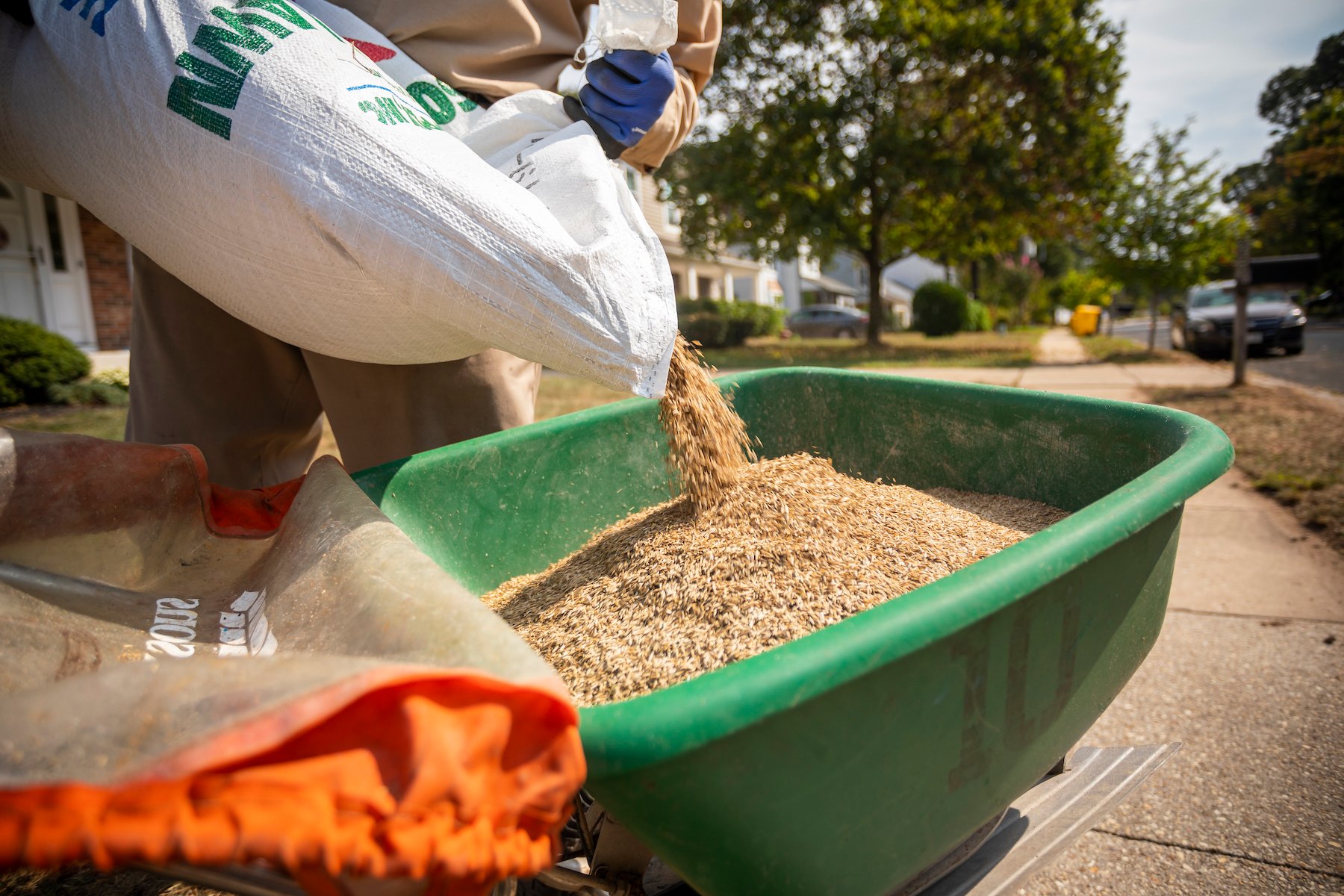 Well, we’re here to set the record straight. Let's look at some important facts about seeding lawns and what you can and can’t do when you’re trying to grow grass in Maryland.
Well, we’re here to set the record straight. Let's look at some important facts about seeding lawns and what you can and can’t do when you’re trying to grow grass in Maryland.
Important Lawn Seeding Facts
A great lawn is essential for your Maryland home. It enhances your home’s appearance by providing well-manicured surroundings that amplify your curb appeal and property value. A healthy lawn is also beneficial to the environment by removing sediment and other contaminants from runoff, preventing them from entering our waterways.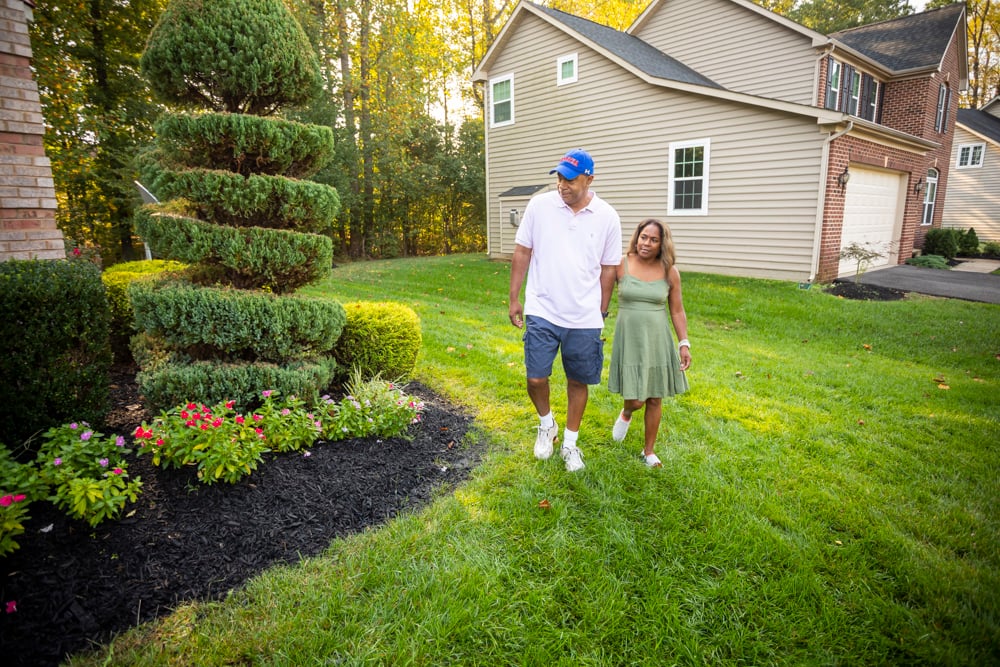 Keeping on top of lawn seeding and what can be combined with this process for the best results is an important part of creating this great home landscape.
Keeping on top of lawn seeding and what can be combined with this process for the best results is an important part of creating this great home landscape.
Use This Tool to Compare Your Local Lawn Care Companies
Here are some essential facts about lawn seeding that will help you avoid any delays in getting the enviable lawn you’re after.
1. The Best Time to Seed a Lawn
Let’s start with the first important factor to consider when seeding a lawn: When should you seed?
Early fall is the best time to seed your lawn in Maryland. Temperatures start to cool down so the seed will have a chance to germinate and begin to grow before winter sets in and then keeps building up its energy for a growth spurt in spring. The strength it builds during these two seasons gives it the power to survive the scorching summer heat. 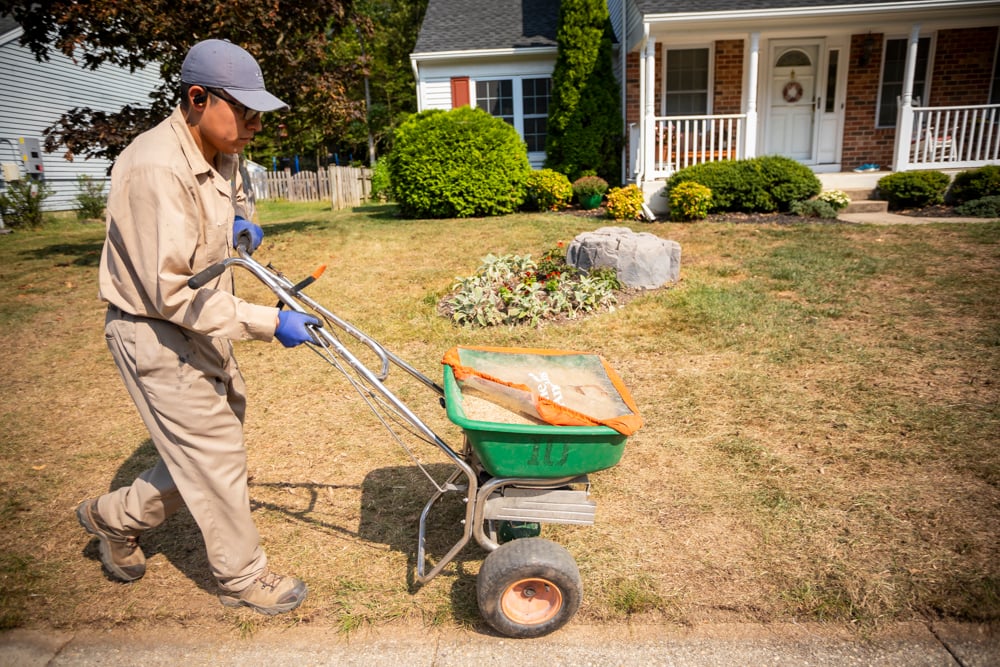 That’s why overseeding or seeding a lawn in the summer is not recommended for the best germination possible. Temperatures are too hot and water evaporates too quickly for new grass plants to thrive.
That’s why overseeding or seeding a lawn in the summer is not recommended for the best germination possible. Temperatures are too hot and water evaporates too quickly for new grass plants to thrive.
If you have to overseed or seed a lawn in the spring, it’s definitely doable because the conditions are OK. But, many times, lawn care companies will not sell a spring seeding without a fall seeding because spring isn’t as successful as fall. Finishing the job usually requires an additional fall seeding.
So, the best time to seed a lawn is in the fall because the lawn gets that extra time to build up energy and establish itself before that next growing season.
2. Should you Seed and Fertilize Your Lawn at The Same Time?
All lawns require nutrients to remain green and healthy. Developing strong, healthy roots takes quite a bit of energy. Unfortunately, most soils lack adequate nutrition for grass to grow well. That’s why proper fertilization is important.
In addition to air and water, lawns need nitrogen, phosphorus, and potassium. Nitrogen aids in new growth, phosphorus encourages root growth and potassium improves overall plant health and hardiness. These nutrients help your lawn thrive, while also enabling it to maintain health through stressors like drought, mowing, and heat.
This is why seeding a lawn and fertilizing can be done together as long as fertilization is performed correctly using the right type of product and in the right amount. Slow-release fertilizer is typically best at this time, and you never want to overfertilize when seeding.
3. When Should You Mow After Seeding?
Mowing weekly during the growing season is an important part of establishing and maintaining a healthy lawn. It encourages thicker growth and that thick grass stand will help keep weeds out.
This is especially important in the spring and summer when grass grows more quickly.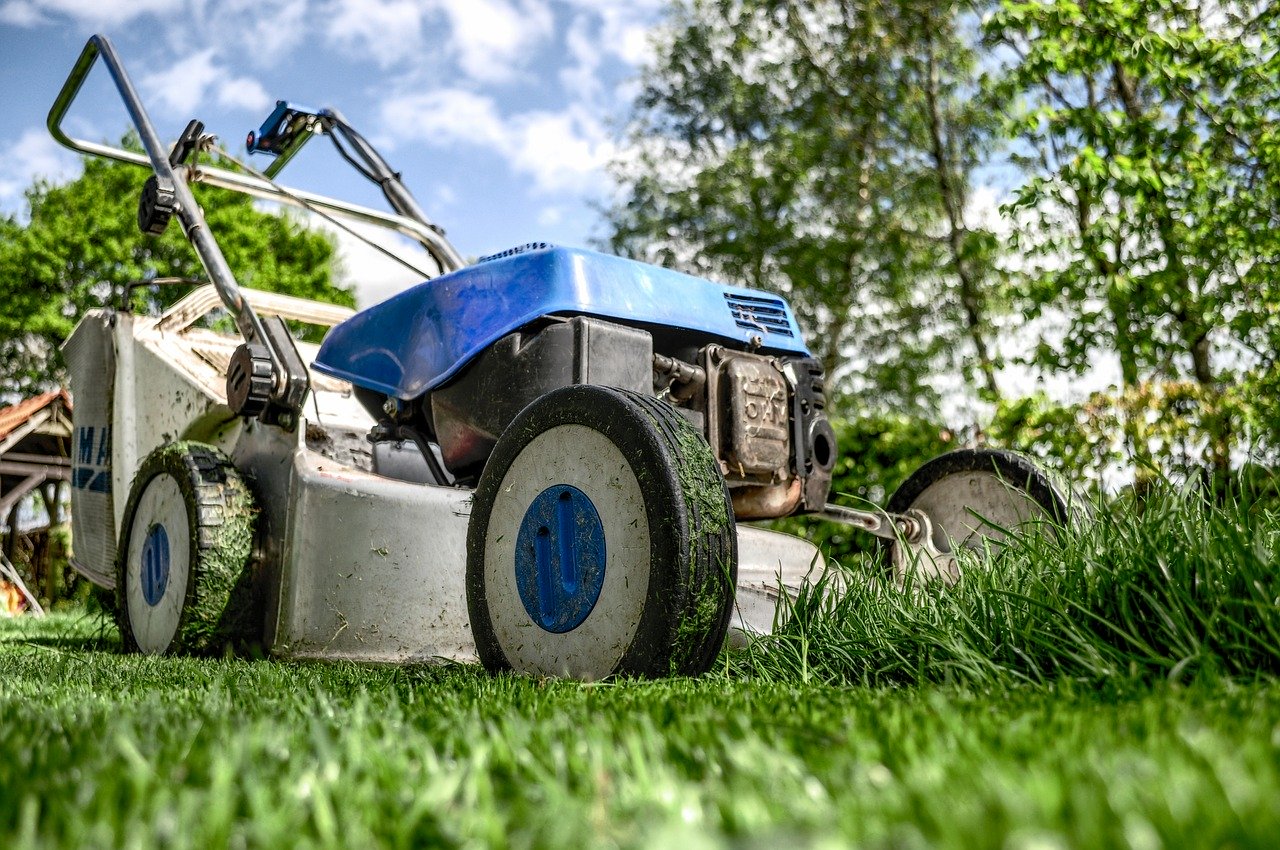 Mowing requires sharp, clean mower blades. It’s okay to resume mowing if the seed is first watered in as this will make it stick to the soil. When should you mow after seeding? When grass first germinates, it’s really tender. It’s important to wait seven to 14 days until the seed has germinated to mow. Don’t collect the clippings; let them fall on the ground so you recycle nutrients and any leftover seed your mower may have picked up.
Mowing requires sharp, clean mower blades. It’s okay to resume mowing if the seed is first watered in as this will make it stick to the soil. When should you mow after seeding? When grass first germinates, it’s really tender. It’s important to wait seven to 14 days until the seed has germinated to mow. Don’t collect the clippings; let them fall on the ground so you recycle nutrients and any leftover seed your mower may have picked up.
4. How to Seed and Beat Weeds Simultaneously
When you’re attempting to grow grass or fill in bare spots in your lawn, you’re trying to create the ideal environment for seed to germinate. So, naturally, weeds will just get in the way. 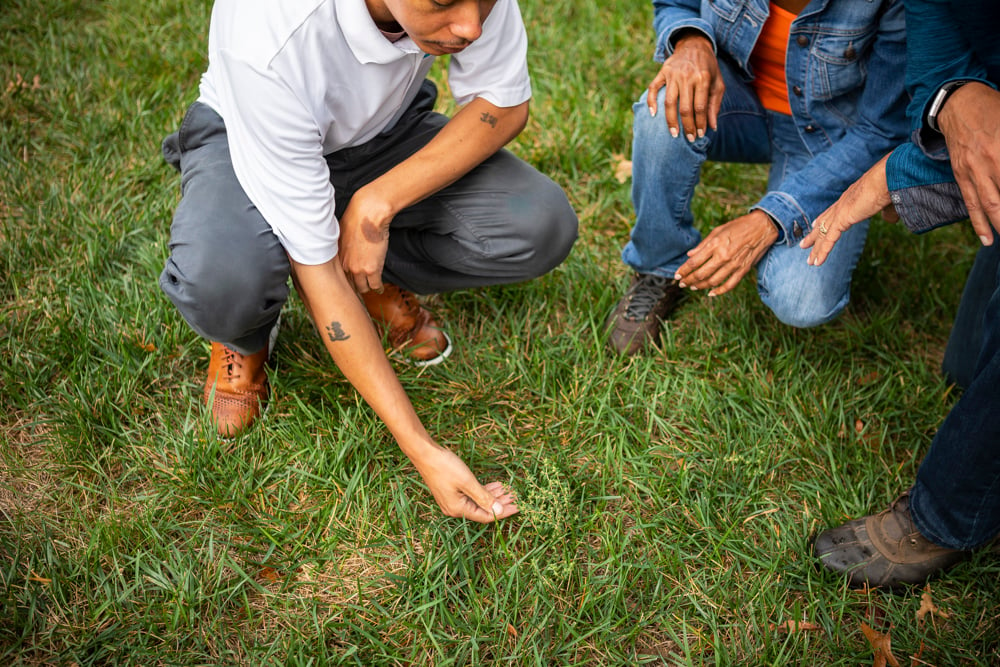 However, you do have to wait until after seed germinates and you’ve mowed it two to three times before you can use any broadleaf herbicide. This amounts to about four to six weeks after seeding.
However, you do have to wait until after seed germinates and you’ve mowed it two to three times before you can use any broadleaf herbicide. This amounts to about four to six weeks after seeding.
The same can be said for grass seed and crabgrass preventer.
5. Lawn Seeding and Lime Treatments
Some lawn care professionals will test your soil when they come to your property for the first time to discover its pH balance.
If your soil needs some correction with lime treatments, that can be done at the same time as seeding or overseeding with no negative impact on germination. In this case, you’re just making the soil better to encourage grass growth.
6. The Aeration and Overseeding Power Combo
When your lawn is tired, thin and has bare spots, core aeration and overseeding can revive it.
A compacted lawn can become stifled and stop absorbing the key ingredients roots need to grow. During aeration, we use an aerator to pull small soil plugs from the lawn, giving the roots a chance to get the oxygen, water, and nutrients they need. 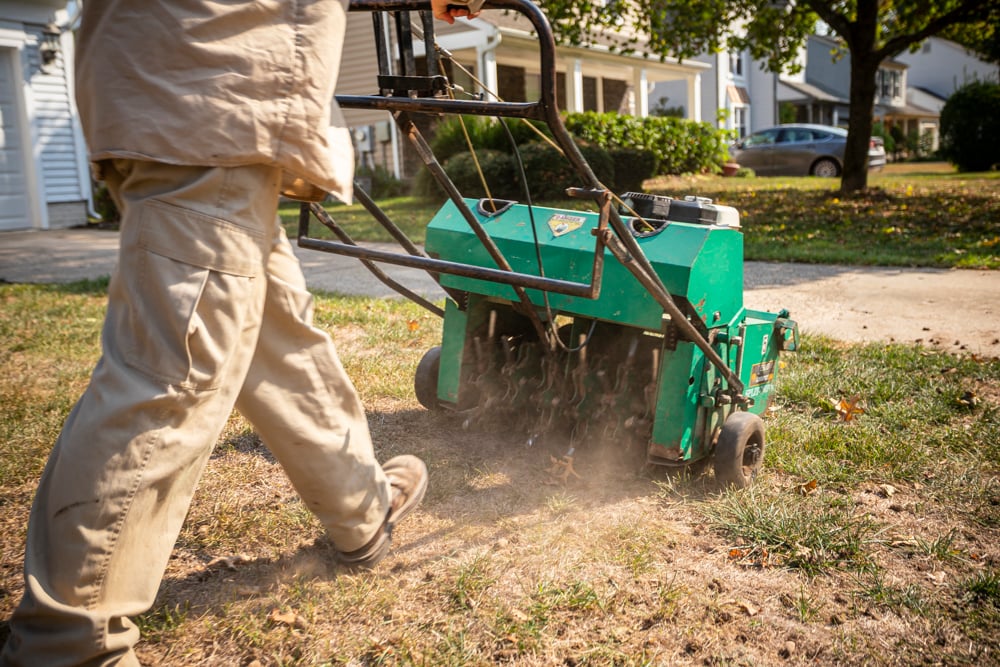 Seeding and aerating the lawn go together very well because you have created great little pockets for those seeds to germinate.
Seeding and aerating the lawn go together very well because you have created great little pockets for those seeds to germinate.
7. Watering Your Lawn After Seeding
After seeding and aerating the lawn, keeping that seed evenly moist is very important.
Typically, watering about one hour per section to get water down 1 to 2 inches into the soil is a good goal. Keep the seed consistently moist but not submerged.
If there’s no rain, you may have to water twice a day to maintain this consistent moisture during germination -- for about 10 to 14 days. Then you can reduce watering to once a day for 30 minutes each section until the lawn is fully established.
Clearing Up Seeding and Lawn Care Myths
We hope this helps answer your burning seeding questions.
Taking care of a lawn is no easy job. It requires knowledge about grass care, mowing, watering, weeding, fertilization, and other treatments and services. We know this can become very confusing with so much information out there. Hopefully, these facts help guide you in the right direction as you care for your Central and Southern Maryland lawn.
Hiring a professional lawn care company that knows all of these tips and tricks can help provide the best results.
Want to boost your lawn’s health and eliminate bare spots without worrying about what treatments might impact seeding? Natural Green Systems can help. Get started today with a free quote. Together, we’ll customize a plan that gives your lawn the facelift it needs.
Image Source: Lawn Mower
There is a lot of information about lawn care floating around out there. Some of it is valuable information, and some of it, unfortunately, is not.
In the meantime, you just want to do what’s right for your lawn. You want it to be green and weed-free. You want to be able to take a stroll through it or have your kids kick the soccer ball on it. There’s nothing wrong with that.
Some of the biggest myths out there center around seeding lawns.
If you’re looking at bare spots in your lawn, you might want to add some seed to those areas to help fill them in. You might also be asking yourself these questions about lawn seeding.
- Should you seed in spring, summer, or fall?
- Can you also fertilize when you seed?
- What about grass seed and weed killer -- can you use one when you’re trying to germinate the other?
- Do seeding and aerating the lawn go together?
You can see how you can talk yourself in circles and be left wondering what to do or blaming the wrong things on why your seed did or didn’t germinate.  Well, we’re here to set the record straight. Let's look at some important facts about seeding lawns and what you can and can’t do when you’re trying to grow grass in Maryland.
Well, we’re here to set the record straight. Let's look at some important facts about seeding lawns and what you can and can’t do when you’re trying to grow grass in Maryland.
Important Lawn Seeding Facts
A great lawn is essential for your Maryland home. It enhances your home’s appearance by providing well-manicured surroundings that amplify your curb appeal and property value. A healthy lawn is also beneficial to the environment by removing sediment and other contaminants from runoff, preventing them from entering our waterways. Keeping on top of lawn seeding and what can be combined with this process for the best results is an important part of creating this great home landscape.
Keeping on top of lawn seeding and what can be combined with this process for the best results is an important part of creating this great home landscape.
Use This Tool to Compare Your Local Lawn Care Companies
Here are some essential facts about lawn seeding that will help you avoid any delays in getting the enviable lawn you’re after.
1. The Best Time to Seed a Lawn
Let’s start with the first important factor to consider when seeding a lawn: When should you seed?
Early fall is the best time to seed your lawn in Maryland. Temperatures start to cool down so the seed will have a chance to germinate and begin to grow before winter sets in and then keeps building up its energy for a growth spurt in spring. The strength it builds during these two seasons gives it the power to survive the scorching summer heat.  That’s why overseeding or seeding a lawn in the summer is not recommended for the best germination possible. Temperatures are too hot and water evaporates too quickly for new grass plants to thrive.
That’s why overseeding or seeding a lawn in the summer is not recommended for the best germination possible. Temperatures are too hot and water evaporates too quickly for new grass plants to thrive.
If you have to overseed or seed a lawn in the spring, it’s definitely doable because the conditions are OK. But, many times, lawn care companies will not sell a spring seeding without a fall seeding because spring isn’t as successful as fall. Finishing the job usually requires an additional fall seeding.
So, the best time to seed a lawn is in the fall because the lawn gets that extra time to build up energy and establish itself before that next growing season.
2. Should you Seed and Fertilize Your Lawn at The Same Time?
All lawns require nutrients to remain green and healthy. Developing strong, healthy roots takes quite a bit of energy. Unfortunately, most soils lack adequate nutrition for grass to grow well. That’s why proper fertilization is important.
In addition to air and water, lawns need nitrogen, phosphorus, and potassium. Nitrogen aids in new growth, phosphorus encourages root growth and potassium improves overall plant health and hardiness. These nutrients help your lawn thrive, while also enabling it to maintain health through stressors like drought, mowing, and heat.
This is why seeding a lawn and fertilizing can be done together as long as fertilization is performed correctly using the right type of product and in the right amount. Slow-release fertilizer is typically best at this time, and you never want to overfertilize when seeding.
3. When Should You Mow After Seeding?
Mowing weekly during the growing season is an important part of establishing and maintaining a healthy lawn. It encourages thicker growth and that thick grass stand will help keep weeds out.
This is especially important in the spring and summer when grass grows more quickly. Mowing requires sharp, clean mower blades. It’s okay to resume mowing if the seed is first watered in as this will make it stick to the soil. When should you mow after seeding? When grass first germinates, it’s really tender. It’s important to wait seven to 14 days until the seed has germinated to mow. Don’t collect the clippings; let them fall on the ground so you recycle nutrients and any leftover seed your mower may have picked up.
Mowing requires sharp, clean mower blades. It’s okay to resume mowing if the seed is first watered in as this will make it stick to the soil. When should you mow after seeding? When grass first germinates, it’s really tender. It’s important to wait seven to 14 days until the seed has germinated to mow. Don’t collect the clippings; let them fall on the ground so you recycle nutrients and any leftover seed your mower may have picked up.
4. How to Seed and Beat Weeds Simultaneously
When you’re attempting to grow grass or fill in bare spots in your lawn, you’re trying to create the ideal environment for seed to germinate. So, naturally, weeds will just get in the way.  However, you do have to wait until after seed germinates and you’ve mowed it two to three times before you can use any broadleaf herbicide. This amounts to about four to six weeks after seeding.
However, you do have to wait until after seed germinates and you’ve mowed it two to three times before you can use any broadleaf herbicide. This amounts to about four to six weeks after seeding.
The same can be said for grass seed and crabgrass preventer.
5. Lawn Seeding and Lime Treatments
Some lawn care professionals will test your soil when they come to your property for the first time to discover its pH balance.
If your soil needs some correction with lime treatments, that can be done at the same time as seeding or overseeding with no negative impact on germination. In this case, you’re just making the soil better to encourage grass growth.
6. The Aeration and Overseeding Power Combo
When your lawn is tired, thin and has bare spots, core aeration and overseeding can revive it.
A compacted lawn can become stifled and stop absorbing the key ingredients roots need to grow. During aeration, we use an aerator to pull small soil plugs from the lawn, giving the roots a chance to get the oxygen, water, and nutrients they need.  Seeding and aerating the lawn go together very well because you have created great little pockets for those seeds to germinate.
Seeding and aerating the lawn go together very well because you have created great little pockets for those seeds to germinate.
7. Watering Your Lawn After Seeding
After seeding and aerating the lawn, keeping that seed evenly moist is very important.
Typically, watering about one hour per section to get water down 1 to 2 inches into the soil is a good goal. Keep the seed consistently moist but not submerged.
If there’s no rain, you may have to water twice a day to maintain this consistent moisture during germination -- for about 10 to 14 days. Then you can reduce watering to once a day for 30 minutes each section until the lawn is fully established.
Clearing Up Seeding and Lawn Care Myths
We hope this helps answer your burning seeding questions.
Taking care of a lawn is no easy job. It requires knowledge about grass care, mowing, watering, weeding, fertilization, and other treatments and services. We know this can become very confusing with so much information out there. Hopefully, these facts help guide you in the right direction as you care for your Central and Southern Maryland lawn.
Hiring a professional lawn care company that knows all of these tips and tricks can help provide the best results.
Want to boost your lawn’s health and eliminate bare spots without worrying about what treatments might impact seeding? Natural Green Systems can help. Get started today with a free quote. Together, we’ll customize a plan that gives your lawn the facelift it needs.
Image Source: Lawn Mower
Share This
Topics: Lawn Care


